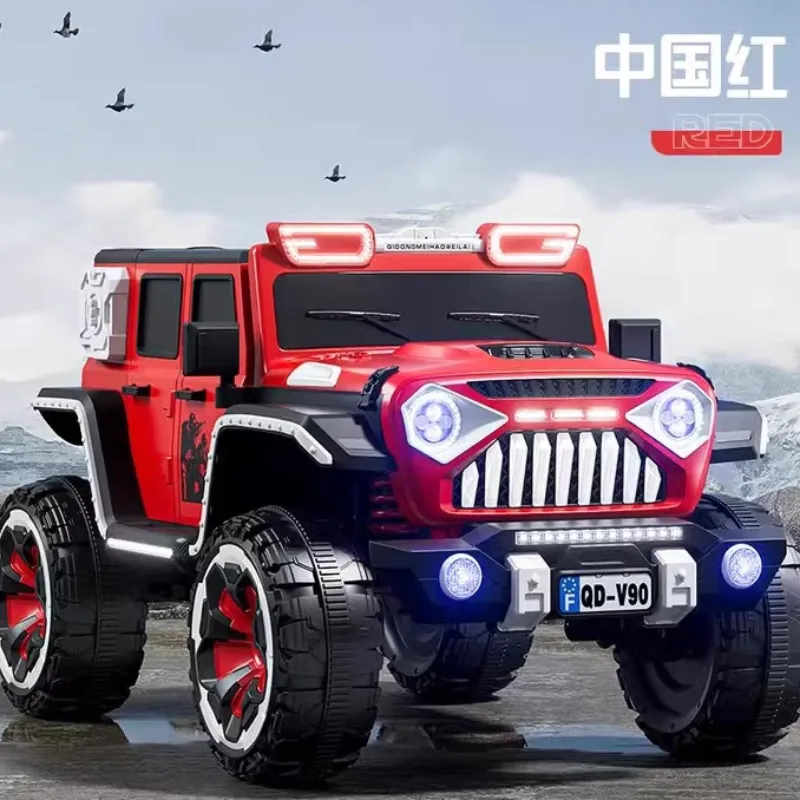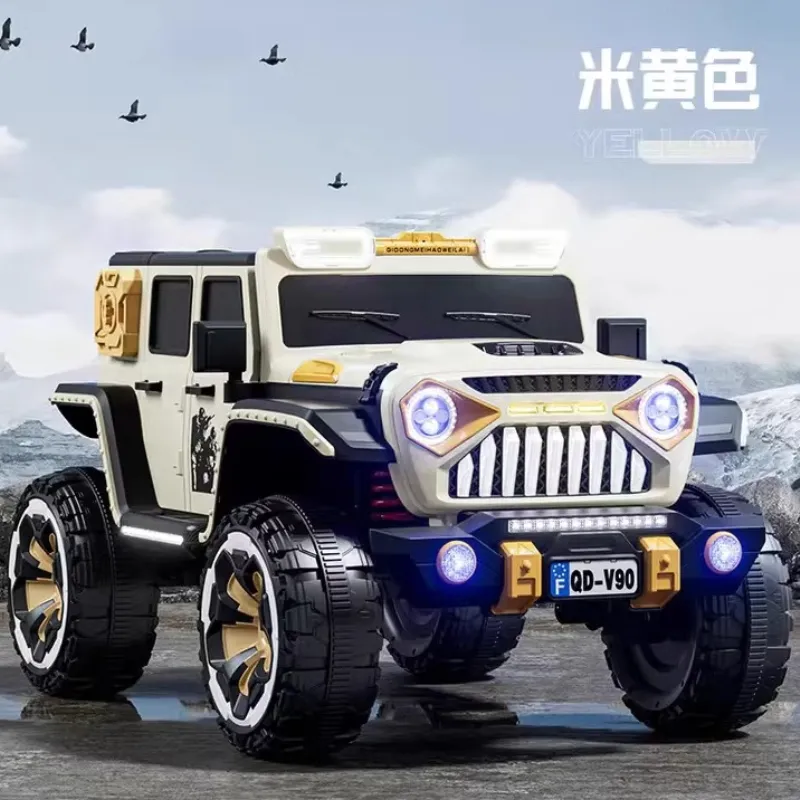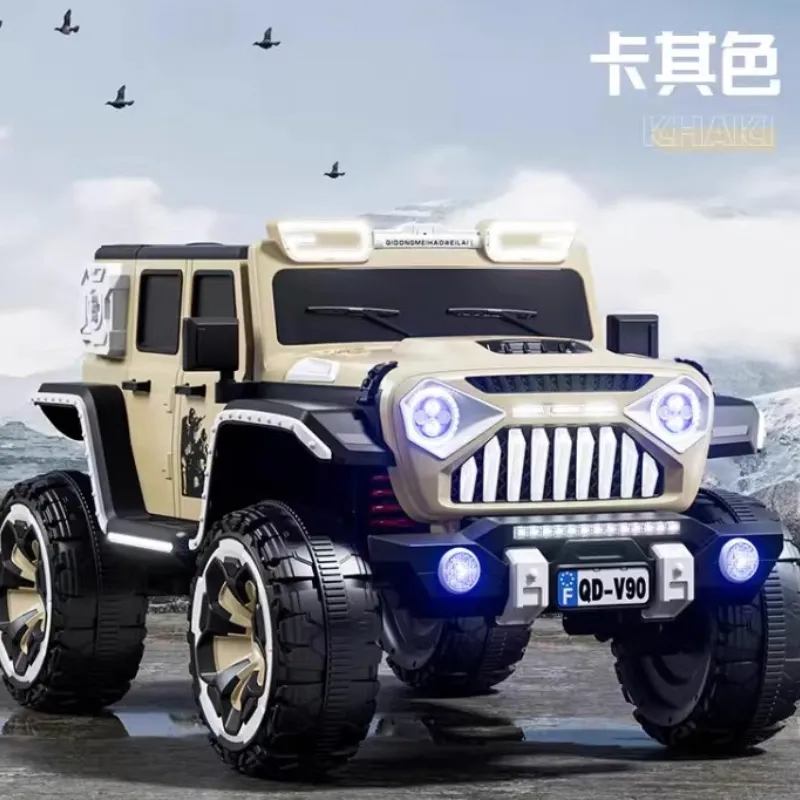Aug . 21, 2025 19:40 Back to list
Best Children's Electric Car Ride Ons - 2 Seater & Audi
The Evolving Landscape of Children's Electric Ride-Ons
The market for children's electric car ride ons has undergone a significant transformation, moving beyond mere toys to sophisticated recreational vehicles that integrate advanced technology, robust safety features, and increasingly realistic designs. This segment is experiencing rapid growth, driven by parental demand for engaging and safe outdoor play experiences, coupled with technological advancements in battery efficiency, motor performance, and remote-control capabilities. Manufacturers are now focusing on durability, extendable lifespans, and features that mimic full-scale automobiles, catering to a discerning B2B clientele ranging from specialized toy retailers and rental services to amusement parks and educational institutions.
Current industry trends indicate a strong shift towards higher-performance models, including the demand for children's electric car 2 seater options, which facilitate shared experiences and enhanced social play. Furthermore, the integration of premium brand licensing, such as the rise in popularity for audi children's electric car models, underscores a market trend towards aspirational products that resonate with brand-conscious consumers. Data from leading market research firms like Grand View Research projects the global ride-on toy market size to reach USD 5.7 billion by 2028, growing at a CAGR of 7.2%, with electric ride-ons forming a substantial and rapidly expanding sub-segment. This growth is bolstered by increasing disposable incomes and a growing emphasis on outdoor activities for children.
Understanding the nuanced technical parameters and stringent safety standards is paramount for businesses looking to invest in high-quality children's ride on electric cars. The longevity and reliability of these products directly impact customer satisfaction and return on investment, making informed procurement decisions crucial.
Precision Engineering: The Manufacturing Process of Children's Electric Vehicles
The production of advanced children's electric car ride ons is a meticulous process demanding high precision, robust material selection, and adherence to rigorous quality control standards. It typically begins with conceptual design and computer-aided design (CAD) modeling, where engineering teams refine structural integrity, ergonomic considerations, and aesthetic appeal.

Material Selection and Preparation
Core components such as the chassis, body panels, and wheels are fabricated from carefully selected materials. High-grade polypropylene (PP) and acrylonitrile butadiene styrene (ABS) plastics are commonly used for bodywork due to their impact resistance, lightweight properties, and ease of molding. For the structural chassis, reinforced steel alloys are often employed, providing the necessary strength and durability to withstand dynamic stresses during use. Battery casings are typically made from fire-retardant plastics to enhance safety. All materials undergo strict incoming quality control (IQC) checks to ensure compliance with global safety standards.
Key Manufacturing Processes
- Injection Molding: The primary process for plastic components like body shells, seats, and dashboards. High-precision molds are used to ensure consistent dimensions and smooth finishes. Modern injection molding machines offer precise temperature and pressure control, minimizing material waste and ensuring part uniformity.
- Steel Fabrication (for Chassis): Steel tubing and sheets are cut, bent, and welded using automated or semi-automated processes to form the robust chassis. Robotic welding ensures strong, consistent joints, which are critical for the structural integrity and long-term safety of the children's electric car.
- Painting and Finishing: Body panels often receive multi-layer painting processes, including primer, color coat, and clear coat, to ensure a durable, scratch-resistant, and aesthetically pleasing finish. This also contributes to the corrosion resistance of exposed metal parts.
- Electronics Assembly: This involves integrating the motor(s), battery pack, wiring harness, control board, and remote-control modules. Soldering and connection processes adhere to strict electrical safety standards, often validated by IPC (Association Connecting Electronics Industries) guidelines.
- Final Assembly: All sub-assemblies (chassis, body, wheels, electronics, steering mechanism) are brought together on an assembly line. This stage includes meticulous fastening, alignment, and functional testing of all moving parts.

Rigorous Testing and Quality Control
Quality control is integrated at every stage, not just at the end. Key testing standards include:
- ISO 9001 Certification: Ensures a robust Quality Management System throughout the manufacturing process.
- ASTM F963 (Standard Consumer Safety Specification for Toy Safety): A comprehensive US standard covering mechanical hazards, flammability, heavy elements, and more.
- EN 71 (European Toy Safety Directive): Covers physical and mechanical properties, flammability, and chemical properties for toys sold in the EU.
- CPSIA (Consumer Product Safety Improvement Act): US law regulating lead content and phthalates in children's products.
- ANSI (American National Standards Institute): Relevant for specific component standards and testing methodologies.
- Functional Testing: Every completed unit undergoes battery charge/discharge cycles, motor performance tests (speed, torque), steering response, remote control range, and braking efficiency checks.
- Durability Testing: Includes drop tests, impact resistance, and continuous operation tests to simulate real-world usage and assess product lifespan. For instance, critical components might be tested to ensure a minimum operational lifespan of 5,000 hours under typical load conditions.
These stringent processes ensure that the final product, like the New children's electric four-wheel off-road vehicle four-wheel drive power remote control multi-function can sit human toy car, meets the highest benchmarks for safety, durability, and performance, guaranteeing a longer service life and higher return on investment for B2B partners.
Technical Superiority and Core Advantages
The technical prowess of modern children's ride on electric cars is a key differentiator in the market. Beyond aesthetics, the underlying engineering determines safety, performance, and longevity.
Advanced Powertrain and Battery Systems
Many high-end children's electric car 2 seater models feature dual-motor or even four-wheel-drive (4WD) configurations, providing enhanced torque and superior traction, especially on uneven terrains. Motors are typically 12V or 24V brushed DC motors, with some premium models incorporating brushless DC (BLDC) motors for greater efficiency, less maintenance, and extended lifespan.
Battery technology has significantly evolved. While sealed lead-acid (SLA) batteries are common due to cost-effectiveness, the trend is moving towards Lithium-ion (Li-ion) batteries for their higher energy density, lighter weight, faster charging times, and longer cycle life. A 12V 7Ah SLA battery might offer 45-60 minutes of run time, while a comparable Li-ion battery could provide 90-120 minutes, with charge times reduced from 8-12 hours to 4-6 hours. This improved efficiency directly translates to better operational readiness for rental fleets and higher satisfaction for end-users.

Enhanced Safety and User Experience Features
- Remote Parental Control: A crucial safety feature allowing adults to override steering and speed, or initiate an emergency stop. This is often implemented via 2.4Ghz Bluetooth technology for secure and interference-free operation.
- Soft Start/Brake System: Gradually increases acceleration and applies brakes smoothly, preventing sudden jolts and ensuring a comfortable and safer ride.
- EVA Rubber Tires: Superior to traditional plastic wheels, EVA foam tires offer better grip, shock absorption, and a quieter ride, mimicking real pneumatic tires without the risk of punctures.
- Adjustable Speeds and Seatbelts: Multiple speed settings cater to different skill levels and environments, while secure seatbelts (often 3-point or 5-point harnesses) ensure child safety.
- LED Lighting and Multimedia: Functional LED headlights, taillights, and dashboards enhance realism. Integrated MP3 players, USB ports, and Bluetooth connectivity allow for entertainment, significantly improving the user experience for children.
Operational Advantages for B2B Applications
For B2B buyers, the advantages of high-quality children's electric car ride ons extend beyond immediate features. Products built with superior materials and processes offer:
- Reduced Maintenance Costs: Durable components and robust construction lead to fewer breakdowns and less frequent part replacements.
- Extended Product Lifespan: A well-engineered electric ride-on can withstand extensive use, critical for rental businesses or high-traffic amusement settings.
- Enhanced Safety Record: Compliance with stringent safety standards minimizes liability risks and builds customer trust.
- Higher Customer Satisfaction: Reliable and feature-rich vehicles provide a superior experience, leading to repeat business and positive word-of-mouth.
These technical advantages collectively contribute to a stronger return on investment and a more sustainable business model for commercial entities utilizing children's electric vehicles.
Key Technical Parameters and Product Comparison
When selecting children's electric car ride ons for commercial deployment, a thorough understanding of key technical parameters is essential. These specifications directly influence performance, safety, and suitability for various applications. Below is a comprehensive table detailing critical parameters, including data relevant to products like our New children's electric four-wheel off-road vehicle.
| Parameter | New Children's Electric Four-Wheel Off-Road Vehicle | Standard 12V Children's Electric Car | Premium Children's Electric Car 2 Seater | Luxury Audi Children's Electric Car (Example) |
|---|---|---|---|---|
| Power System (Voltage) | 24V (Dual 12V Batteries) | 12V | 24V (Dual 12V or Single 24V) | 12V or 24V |
| Motors | 4 x 45W (Four-Wheel Drive) | 2 x 35W (Rear-Wheel Drive) | 2 x 45W or 2 x 90W (AWD options) | 2 x 45W (Licensed models) |
| Battery Capacity | 2 x 7Ah SLA (or upgrade to 10Ah Li-ion) | 1 x 7Ah SLA | 2 x 7Ah SLA or 1 x 10Ah Li-ion | 1 x 7Ah or 1 x 10Ah SLA |
| Max Speed | 3-8 km/h (Multiple speeds) | 3-5 km/h (Single speed) | 5-10 km/h (Multiple speeds) | 3-7 km/h (Multiple speeds) |
| Run Time (Avg.) | 60-120 minutes (depending on terrain/load) | 45-60 minutes | 90-180 minutes | 60-90 minutes |
| Max Load Capacity | 50-60 kg (2 children) | 30 kg (1 child) | 50-80 kg (2 children) | 30-50 kg (1-2 children) |
| Tire Type | Large EVA Rubber Tires | Plastic with Traction Strip | EVA Rubber Tires | EVA Rubber or Rubberized Plastic |
| Suspension | Full Spring Suspension | None or Basic Rear | Full Spring Suspension | Limited or Full Suspension |
| Safety Features | Remote Control, Soft Start, Seatbelts, Auto Brake | Basic Remote Control, Seatbelt | Full Suite (Remote, Soft Start, 5-point harness) | Remote Control, Soft Start, Seatbelt |
| Age Range | 3-8 years | 1-4 years | 3-9 years | 3-7 years |

This comparison highlights that our New children's electric four-wheel off-road vehicle, with its 4WD system, robust 24V power, and full suspension, stands out as a high-performance option ideal for diverse commercial applications requiring superior traction and durability, outperforming many standard and even some premium children's electric car offerings in key performance metrics.
Application Scenarios and Customization Solutions
The versatility of high-quality children's ride on electric cars makes them suitable for a myriad of B2B applications, extending far beyond traditional retail. Their robust construction and advanced features enable deployment in demanding commercial environments, driving revenue and enhancing customer engagement.
Typical Application Scenarios
- Amusement Parks and Family Entertainment Centers (FECs): Ideal for dedicated ride-on tracks or themed areas, providing a popular paid attraction. The durability and ease of maintenance are critical here for continuous operation.
- Rental Fleets: Businesses specializing in event rentals, children's parties, or hourly rentals in public parks benefit from multi-seater options like a children's electric car 2 seater, which maximizes per-use revenue. The long battery life and quick charge cycles are essential.
- Educational Institutions and Daycares: Used as part of outdoor play equipment, promoting motor skill development, spatial awareness, and cooperative play. Safety features like parental remote control are highly valued.
- High-End Retail Display and Promotion: For automotive dealerships (e.g., an audi children's electric car for an Audi showroom), these vehicles serve as aspirational marketing tools, creating an immersive brand experience for families.
- Resorts and Hotels: Offering guests premium amenities, including rental of electric ride-ons for children to explore designated areas safely.
- Large Private Estates/Residential Communities: For shared recreational facilities, durable and low-maintenance electric cars are a valuable addition.

Tailored Customization Solutions
Recognizing the diverse needs of our B2B partners, we offer comprehensive customization options for our children's electric car ride ons to perfectly align with specific operational requirements and brand identities.
- Branding and Livery: Custom color schemes, applied decals, and logos to match corporate branding or theme park aesthetics. For instance, a rental fleet might require specific numbering or QR codes integrated into the design for inventory management.
- Performance Upgrades: Options for higher-capacity Lithium-ion batteries for extended run times, more powerful motors for increased torque on challenging terrains, or upgraded suspension systems for enhanced comfort and durability in heavy-use scenarios.
- Safety Enhancements: Integration of specialized safety features such as GPS tracking for fleet management, anti-theft alarms, or custom speed governors tailored to specific track layouts or age groups.
- Integrated Technology: Addition of custom audio systems, interactive dashboards, or even small display screens for educational content or interactive games, enhancing the engagement factor.
- Fleet Management Solutions: For large deployments, we can integrate telematics systems that provide data on usage patterns, battery status, and maintenance alerts, optimizing operational efficiency and minimizing downtime.
Our engineering and production teams work closely with clients to design and implement these modifications, ensuring that each solution is robust, compliant with relevant safety standards, and delivers measurable value. This bespoke approach ensures that whether for a thriving rental business or a high-traffic amusement park, our children's electric car products are not just off-the-shelf toys but strategic assets tailored for optimal performance and profitability.
Ensuring Trust: Authoritativeness and Transparency
In the B2B sector for children's electric car ride ons, trust is built upon a foundation of proven reliability, adherence to global standards, and comprehensive customer support. Our commitment to expertise and authoritativeness is reflected in every stage, from design to after-sales service.
Certifications and Compliance
All our children's electric car models, including the New children's electric four-wheel off-road vehicle, undergo rigorous testing and achieve multiple international safety and quality certifications. These include, but are not limited to:
- CE Marking: Mandatory for products sold within the European Economic Area, signifying compliance with health, safety, and environmental protection standards.
- FCC (Federal Communications Commission): For electronic products sold in the United States, ensuring electromagnetic compatibility and preventing interference.
- RoHS (Restriction of Hazardous Substances): Compliance ensures that hazardous materials are not used in the manufacturing process, safeguarding children and the environment.
- ISO 9001:2015: Our manufacturing facilities maintain this globally recognized standard for quality management systems, ensuring consistent product quality and continuous improvement.
- ASTM F963 & EN 71: As detailed earlier, these toy safety standards are strictly adhered to, covering mechanical, physical, and chemical properties.
Warranty and After-Sales Support
We stand behind the quality of our products with a robust warranty program. Typically, our children's electric car ride ons come with a 1-year limited warranty covering manufacturing defects for key components like motors and control boards, and a 6-month warranty for batteries. Detailed warranty terms are provided with each order, outlining coverage and claims processes.
Our dedicated technical support team is available to assist B2B clients with troubleshooting, maintenance guidance, and spare parts procurement. We maintain a comprehensive inventory of replacement parts to ensure minimal downtime for commercial operations. Support channels include direct phone lines, email, and an online knowledge base with FAQs and instructional videos.
Delivery and Logistics
Understanding the critical nature of timely delivery for B2B operations, we have streamlined our logistics process. Standard production lead times for bulk orders of children's electric car 2 seater or single-seater models typically range from 20 to 45 business days, depending on order volume and customization requirements. Expedited shipping options are available upon request. We work with reputable international freight forwarders to ensure secure and efficient delivery worldwide, providing transparent tracking information from dispatch to arrival.
Frequently Asked Questions (FAQ) for B2B Buyers
This section addresses common inquiries from commercial clients regarding the procurement, operation, and maintenance of children's electric car ride ons.
Q1: What is the recommended charging protocol for optimizing battery life in a commercial fleet?
A1: For commercial use, we recommend a consistent charging routine. For SLA batteries, avoid deep discharge; charge them after each use, or at least every 2-3 months during storage. For Li-ion batteries, partial charges are fine, but avoid letting them sit at 0% or 100% for extended periods. Always use the manufacturer-provided charger, as it's optimized for the battery's chemistry and voltage. Overcharging or undercharging can significantly reduce battery lifespan. Implementing a smart charging station can help automate and monitor this process for fleet efficiency.
Q2: How do your electric ride-ons withstand heavy commercial usage, particularly concerning wear and tear on components?
A2: Our children's electric car models are designed with commercial durability in mind. We use reinforced chassis materials, high-grade plastics, and robust motor assemblies. Components prone to wear, such as wheels and gearboxes, are engineered for easy replacement and are available as spare parts. The 4WD system and EVA rubber tires on models like our New children's electric four-wheel off-road vehicle contribute significantly to improved traction and reduced wear on challenging surfaces, leading to a longer operational life compared to standard plastic-wheeled variants. Regular preventative maintenance, as outlined in our user manual, further extends product lifespan.
Q3: Can we customize the speed settings for different age groups or operational zones within our facility?
A3: Yes, most of our premium children's electric car ride ons come with adjustable speed settings directly on the vehicle's control panel or via the parental remote control. This allows operators to set appropriate maximum speeds (e.g., a low speed of 3 km/h for younger children or tighter spaces, and a higher speed of 8 km/h for older children on open tracks). For specific custom requirements, our engineering team can integrate custom speed governors or geofencing solutions for large-scale deployments, ensuring vehicles operate within designated speed limits in pre-defined areas.
Q4: What is the typical lead time for large bulk orders, and what are the shipping options?
A4: For bulk orders of 50 units or more, the typical production lead time is approximately 30-45 business days, depending on the complexity of customization and current production schedules. We offer various shipping options, including FCL (Full Container Load) and LCL (Less than Container Load) via sea freight, and air freight for smaller, urgent orders. We will provide detailed shipping quotes and estimated delivery times based on your specific order volume and destination. All shipments are carefully packed to prevent damage during transit.
Q5: What are the key distinctions between a 12V and a 24V children's electric car 2 seater, and which is better for commercial use?
A5: The primary distinction lies in power output and sustained performance. A 24V system, typically achieved with two 12V batteries in series, provides more power to the motors. This translates to higher top speeds, increased torque for navigating inclines or rougher terrains, and the ability to handle heavier loads more efficiently. For commercial use, especially with children's electric car 2 seater models that accommodate two children, or for use in amusement parks with varied terrain, a 24V system (like that in our New children's electric four-wheel off-road vehicle) is generally superior. It offers better performance, extended battery life under heavy load, and a more robust overall experience, leading to greater customer satisfaction and reduced operational strain on the vehicles. While 12V models are suitable for lighter use and flatter surfaces, 24V systems offer the reliability and performance demanded by high-volume commercial applications.
References
- Grand View Research. (2021). Ride-On Toy Market Size, Share & Trends Analysis Report By Product (Scooters & Skateboards, Wagons, Tricycles & Bikes, Electric Ride-Ons), By Region, And Segment Forecasts, 2021 - 2028.
- American Society for Testing and Materials (ASTM) International. (2023). ASTM F963: Standard Consumer Safety Specification for Toy Safety.
- European Committee for Standardization (CEN). (2022). EN 71: Safety of Toys.
- International Organization for Standardization (ISO). (2015). ISO 9001:2015 - Quality management systems — Requirements.
- U.S. Consumer Product Safety Commission (CPSC). (2008). Consumer Product Safety Improvement Act (CPSIA) of 2008.
-
Discover Top E Bike Brand Insights, Specs & Future Trends | Yanline Bike
NewsNov.24,2025
-
Green E Bike – The Future of Sustainable Urban Mobility
NewsNov.24,2025
-
Ruffian eBike: Durable, Efficient Electric Bikes for Modern Mobility
NewsNov.23,2025
-
Comprehensive Guide to the Global E Bike Market and Future Trends
NewsNov.23,2025
-
Understanding Electric Bicycle Range: A Complete Guide for Smarter E-Bike Use
NewsNov.22,2025
-
Ceron Electric Bike – Efficient, Sustainable Urban Mobility Solutions
NewsNov.22,2025
-
Discover the Benefits and Innovations of Go Ebike | Sustainable Urban Mobility
NewsNov.22,2025




